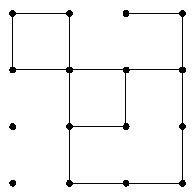 |
| ||||
Home Page
F.A.Qs
Statistical Charts
Past Contests
Scheduled Contests
Award Contest
| ||||||||||
| Online Judge | Problem Set | Authors | Online Contests | User | ||||||
|---|---|---|---|---|---|---|---|---|---|---|
| Web Board Home Page F.A.Qs Statistical Charts | Current Contest Past Contests Scheduled Contests Award Contest | |||||||||
|
Language: Squares
Description A children's board game consists of a square array of dots that contains lines connecting some dots. One part of the game requires that the players count the number of squares that are formed by these lines. For example, in the figure shown below, there are 3 squares, 2 of size 1 and 1 of size 2 , so the total number of squares is 3. (The "size" of a square is the number of lines segments required to form a side.)
 Your task is to write a program to count the number of all the possible squares. Input The input represents a series of game boards. Each board consists of a description of a square array of n ^ 2 dots (where 2 <= n <= 1500) and some interconnecting horizontal and vertical lines. A record of a single board with n ^ 2 dots and m (m <= 300000 )interconnecting lines is formatted as follows:
Line 1: "n" the number of dots in a single row or column. Line 2: "m" the number of interconnecting lines. Each of the next m lines are one of following two types: "H i j k" (1 <= i, j <= n, k >0, j + k <= n) indicates a horizontal line of length k from the dot in row i, column j to the dot in row i, column j + k. or "V i j k" (1 <= i, j <= n, k >0, i + k <= n) indicates a vertical line of length k from the dot in row i, column j to the dot in row i + k, column j. The end of input is indicated by end-of-file. Output For each record print only one integer, which is the number of squares. Sample Input 4 9 H 1 1 1 H 1 3 1 H 2 1 3 H 3 2 1 H 4 2 2 V 1 1 1 V 1 2 3 V 2 3 1 V 1 4 3 4 9 H 1 1 1 H 1 3 1 H 2 1 3 H 3 2 1 H 4 2 2 V 1 1 1 V 1 2 3 V 2 3 1 V 1 4 3 Sample Output 3 3 Source POJ Monthly,Guang Lin |
[Submit] [Go Back] [Status] [Discuss]
All Rights Reserved 2003-2013 Ying Fuchen,Xu Pengcheng,Xie Di
Any problem, Please Contact Administrator